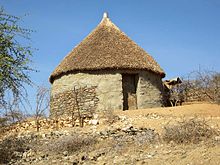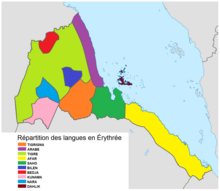
Sources disagree as to the current population of Eritrea, with some proposing numbers as low as 3.6 million and others as high as 6.7 million. Eritrea has never conducted an official government census.

The music of Eritrea, is a diverse mix of traditional and popular styles originating from ancient to modern times. The nine major ethnic groups of Eritrea—Afar, Bilen, Hedareb, Kunama, Nara, Rashaida, Saho, Tigre and Tigrinya—celebrate autonomous music-making expressed through a rich heritage of vocalists, instrumentalists and activities within the country and throughout the international diaspora. The country's music is informed by a range of ethnolinguistic group dynamics in the region, by its shared pre-colonial history with and revolutionized independence from Ethiopia, and by its exposure to globalized American music in the mid-twentieth century.
The Saho language is an Afro-Asiatic language spoken in Eritrea, Sudan and Ethiopia. It belongs to the family's Cushitic branch.
The Agaw or Central Cushitic languages are Afro-Asiatic languages spoken by several groups in Ethiopia and, in one case, Eritrea. They form the main substratum influence on Amharic and other Ethiopian Semitic languages.
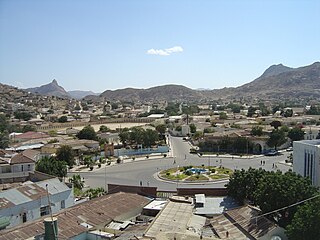
Keren, historically known as Sanhit, is the second-largest city in Eritrea. It is situated around 91 kilometres (57 mi) northwest of Asmara at an elevation of 1,590 metres (5,220 ft) above sea-level. The city sprawls on a wide basin surrounded by granitic mountains on all sides. It serves as the capital of the Anseba Region, and is home to a number of ethnic groups including the Bilen people and Tigre people.

The Agaw or Agew are a Cushitic ethnic group native to the northern highlands of Ethiopia and neighboring Eritrea. They speak the Agaw languages, also known as the Central Cushitic languages, which belong to the Cushitic branch of the Afroasiatic language family, and are therefore closely related to peoples speaking other Cushitic languages.
Habesha peoples is an ethnic or pan-ethnic identifier that has been historically employed to refer to Semitic language-speaking and predominantly Oriental Orthodox Christian peoples found in the highlands of Ethiopia and Eritrea between Asmara and Addis Ababa and this usage remains common today. The term is also used in varying degrees of inclusion and exclusion of other groups.
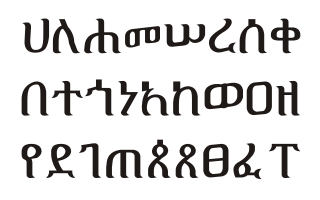
Geʽez is a script used as an abugida (alphasyllabary) for several Afro-Asiatic and Nilo-Saharan languages of Ethiopia and Eritrea. It originated as an abjad and was first used to write the Geʽez language, now the liturgical language of the Ethiopian Orthodox Tewahedo Church, the Eritrean Orthodox Tewahedo Church, the Eritrean Catholic Church, the Ethiopian Catholic Church, and Haymanot Judaism of the Beta Israel Jewish community in Ethiopia. In the languages Amharic and Tigrinya, the script is often called fidäl (ፊደል), meaning "script" or "letter". Under the Unicode Standard and ISO 15924, it is defined as Ethiopic text.

Tigray Province, also known as Tigre, was a historical province of northern Ethiopia that overlayed the present day Afar and Tigray regions. Akele Guzai borders with the Tigray province. It encompassed most of the territories of Tigrinya-speakers in Ethiopia. Tigray was separated from the northern Tigrinya speaking territories by the Mareb River, now serving as the state border to Eritrea, bordering Amhara region in the south.
The Saho are a Cushitic ethnic group who inhabit large sections of Eritrea and northern Ethiopia. They speak Saho as a mother tongue.

The languages of Ethiopia include the official languages of Ethiopia, its national and regional languages, and a large number of minority languages, as well as foreign languages.
The Tigre people are an ethnic group indigenous to Eritrea. They mainly inhabit the lowlands and northern highlands of Eritrea.
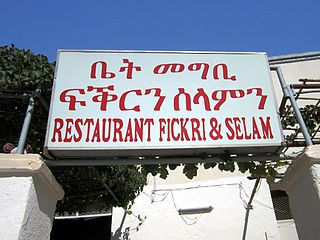
The main languages spoken in Eritrea are Tigrinya, Tigre, Kunama, Bilen, Nara, Saho, Afar, and Beja. The country's working languages are Tigrinya, Arabic, English.

The Bilen language is spoken by the Bilen people in and around the city of Keren in Eritrea. It is the only Agaw language spoken in Eritrea. It is spoken by about 116,000 people.

The Nara are an ethnic group inhabiting southwestern Eritrea. The society is divided into four subtribes, who are traditionally animist. They are mostly subsistence farmers.
Articles related to Eritrea include:

Eritreans are the native inhabitants of Eritrea, as well as the global diaspora of Eritrea. Eritreans constitute several component ethnic groups, some of which are related to ethnic groups that make up the Ethiopian people in neighboring Ethiopia and people groups in other parts of the Horn of Africa. Nine of these component ethnic groups are officially recognized by the Government of Eritrea.

Eritrea is a country in the Horn of Africa. Eritrea is the Italian form of the Greek name Ἐρυθραίᾱ, meaning "red [land]". With its capital at Asmara, it is bordered by Sudan in the west, Ethiopia in the south, and Djibouti in the southeast. The northeastern and eastern parts of Eritrea have an extensive coastline along the Red Sea, directly across from Saudi Arabia and Yemen. The nation has a total area of approximately 117,600 km2 (45,406 sq mi), and includes the Dahlak Archipelago and several of the Hanish Islands.

Religion in Eritrea consists of a number of faiths. The two major religions in Eritrea are Christianity and Islam. However, the number of adherents of each faith is subject to debate. Estimates of the Christian share of the population range from 47% and 63%, while estimates of the Muslim share of the population range from 37% to 52%.
The Zaul are an Agaw people and Tigrinya people who inhabit the southern and central regions of Eritrea, in a territory known as the Eritrean highlands. They are spread across several villages and have largely assimilated to other ethnic groups within the country.
